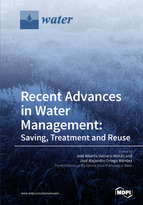Recent Advances in Water Management: Saving, Treatment and Reuse
A special issue of Water (ISSN 2073-4441). This special issue belongs to the section "Water Resources Management, Policy and Governance".
Deadline for manuscript submissions: closed (15 December 2017) | Viewed by 90073
Special Issue Editors
Interests: wastewater treatment; constructed wetland; biofilters; ponds; advanced oxidation technologies; wastewater disinfection
Special Issues, Collections and Topics in MDPI journals
Special Issue Information
Dear Colleagues,
One of the great challenges facing humanity is the availability of water in sufficient quantity and quality to meet needs. In addition, such availability must be environmentally and economically sustainable. Continued population growth, pollution, and climate change make it even more difficult to achieve this challenge.
Thus, if the goal is to develop and implement sustainable, environmental, and economic methods to provide water with the necessary quality for all people, it will be imperative to make use of all tools available. There are many measures of different natures that must be considered and include, not only technological, but also educational and political ones. Some of them are:
-
Water demand control: Implementation of saving systems/devices in homes, agriculture, industries, new industrial production methods with reduced water consumption, control of water leaks in distribution systems, etc.
-
Water production: Desalinization and desalination methods, rain and fog harvest, potabilization, etc.
-
Wastewater treatment and reuse: Grey water segregation, wastewater treatment methods such as membrane methods and advanced oxidation techniques, natural treatment systems such as ponds and constructed wetlands, evaluation of benefits and threats of using treated wastewater in agriculture, sludge reuse alternatives, etc.
The objective of this Special Issue is to give an idea of the state-of-the-art of development and implementation of the different technological, educational, and political methods, and initiatives aimed at achieving sustainable water management around the world.
Prof. Dr. José Alberto Herrera-Melián
Prof. Dr. José Alejandro Ortega Méndez
Guest Editor
Manuscript Submission Information
Manuscripts should be submitted online at www.mdpi.com by registering and logging in to this website. Once you are registered, click here to go to the submission form. Manuscripts can be submitted until the deadline. All submissions that pass pre-check are peer-reviewed. Accepted papers will be published continuously in the journal (as soon as accepted) and will be listed together on the special issue website. Research articles, review articles as well as short communications are invited. For planned papers, a title and short abstract (about 100 words) can be sent to the Editorial Office for announcement on this website.
Submitted manuscripts should not have been published previously, nor be under consideration for publication elsewhere (except conference proceedings papers). All manuscripts are thoroughly refereed through a single-blind peer-review process. A guide for authors and other relevant information for submission of manuscripts is available on the Instructions for Authors page. Water is an international peer-reviewed open access semimonthly journal published by MDPI.
Please visit the Instructions for Authors page before submitting a manuscript. The Article Processing Charge (APC) for publication in this open access journal is 2600 CHF (Swiss Francs). Submitted papers should be well formatted and use good English. Authors may use MDPI's English editing service prior to publication or during author revisions.
Keywords
- Water saving devices
- rain harvest
- wastewater segregation
- grey water treatment
- alternative wastewater treatment
- treated wastewater reuse







